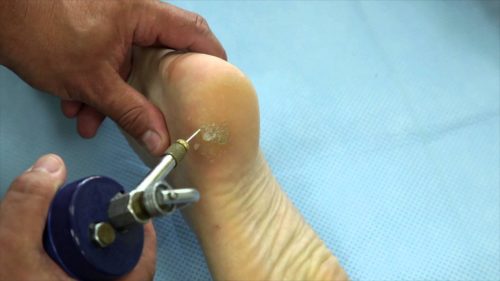admin
Latest posts by admin (see all)
- Wart Cream: Which One to Choose? - October 14, 2019
- Wart Freeze: How Does the Cryodestruction Take Place? - October 11, 2019
- How to Use Salicylic Acid for Warts Removal? - October 8, 2019
According to various data, 70-90% of people of reproductive age are infected with HPV in the world. Human Papilloma Virus (HPV) is an extensively distributed sexually transmitted infection: between 80 and 90% of women face HPV infection during life. The peculiarity of the virus is that for many years it can not manifest itself in any way, but in the end it leads to the development of genital organs diseases – both benign, for example, papilloma, and malignant (among them, cervical cancer).
Most people learn about the human papilloma virus (HPV), as a rule, when it visibly makes itself felt: warts appear. Is it possible to get rid of the virus once and forever? How to avoid cancer, which this virus provokes? Let’s check what you can do to protect yourself from the negative consequences of the HPV.
Contents
- Types of HPV: Non-Oncogenic and Oncogenic
- Cervical cancer and HPV: Is there a connection
- Is It Possible to Treat HPV
- What Is Included in HPV Wart Treatment
- Preventative Measure against HPV
Types of HPV: Non-Oncogenic and Oncogenic
At the moment, there are about a hundred strains of the human papillomavirus. Scientists did not invent ingenious names for each type, but simply denoted them with numbers. For example, HPV 1, 2, 3, and so up to 100. Strains differ from each other in many parameters, but the most important property of the virus is its oncogeneity (that is, the ability to transform ordinary body tissues into malignant ones).
Scientists conditionally divide the papilloma viruses into three types:
- non-oncogenic – 1, 2, 3, 5;
- papilloma viruses of low oncogenic risk – mostly numbers 6, 11, 42, 43, 44;
- papilloma viruses of high oncogenic risk – 16, 18, 31, 33, 35, 39, 45, 51, 52, 56, 58, 59 and 68.
More than 40 types can cause various lesions of the anogenital tract (genital and anus) of men and women. Highly cancerous types of HPV 16 and 18 occur in 70% of cases, type 16 leads in 41-54% of cases to cancer. Recently, scientists have discovered oncogenic properties of strains that have been previously considered safe.
Once in the body, the virus penetrates into the lower layer of the epithelium, the most vulnerable being the zone of transition of the multilayered planar epithelium of the cervix into a cylindrical one. In an infected cell, the virus exists in two forms: benign, when it lives outside the host chromosome, and malignant when the virus DNA is inserted into the genome and causes tissue degeneration.
The incubation period lasts from several weeks to several years.That’s why it is recommended to be examined regularly.
Cervical cancer and HPV: Is there a connection
Cervical cancer in 93% of cases develops as a result of HPV infection of high oncogenic risk. The most dangerous of them are types 16,18,45 and 56. A tiny viral particle consisting of only 8-10 proteins, being introduced into cells of the cervical mucosa, triggers specific processes, leading to the development of dysplasia – the precancerous state. The transition of dysplasia into cancer occurs under the influence of female sex hormones, namely – one of the products of the chemical transformation of estrogen.
That is why papillomavirus infection leads to the development of malignant neoplasms mainly in women, and in men it is more often asymptomatic, sometimes manifesting themselves as warts or genital warts.
According to the WHO, every day about 1,300 women in the world develop cervical cancer caused by HPV. Increasingly, young girls aged 15-20 are the victims of this dangerous disease. More than 240,000 women die from cervical cancer every year.
To prevent the development of cervical cancer, timely treatment of HPV is necessary. All women infected with HPV should visit the gynecologist every six months and undergo an analysis for oncocytology.
Is It Possible to Treat HPV
It is proved that a healthy and strong immune system in some cases is able to cope with HPV independently. In people younger than 30 years of age, spontaneous cure for the virus often occurs within 2 years from the moment of infection.
The situation is different in people with weakened immunity. At them the virus can take root for a long time in an organism, becoming invulnerable for immune system and traditional treatment. A poor prognostic sign is the preservation of the virus in the body for more than 2 years. In this case, they talk about the chronic carrier of HPV.
For many years, it was believed that it is impossible to completely cure HPV at this stage. All the efforts of the doctors were aimed at slowing down the process and getting rid of the clinical manifestations of the infection. However, the carrier of the virus persisted, which forced people to live for many years in the “expectation” of a relapse.Fortunately, science does not stand still, and now effective schemes for getting rid of HPV are developed.
What Is Included in HPV Wart Treatment
Since a complete cure for papillomavirus infection is currently impossible, HPV manifestations are treated, and not the presence of the virus in the body. At the same time, the effectiveness of different methods of treatment is 50-70%, and in a quarter of cases the disease manifests itself several months after the end of treatment. The question of the appropriateness of the treatment of each patient is chosen by the doctor individually. In this case, it is necessary to avoid factors that reduce immunity (hypothermia, severe emotional stress, chronic fatigue, beriberi). There are studies that claim about the preventive effect of retinoids (beta-carotene and vitamin A), vitamin C and trace elements, such as folate, on diseases caused by HPV.
The easiest way to get rid of papillomas on the skin and mucous membranes is to remove the growths with the use of electrocoagulation, radio-knife, laser therapy, cryodestruction, or by excision operatively. But along with radical removal of neoplasms, a complex drug approach is often used, which includes antiviral or immunomodulatory therapy. Traditionally, such drugs as:
- vitamin complexes;
- antiviral drugs;
- immunomodulators.
In a separate form, such drugs are in most cases unable to cope with HPV manifestations in women and men – warts. However, as part of complex therapy, such drugs can achieve better results. The most productive will be the use of complex treatment to remove old and large warts.
What is included in antiviral therapy? Before you buy any medicine in the pharmacy, you need to undergo a comprehensive examination. It is necessary because it not only allows you to determine as precisely as possible which drug can help, but also helps to identify the nature of the build-up. Sometimes under the guise of a seemingly innocuous wart, a malignant tumor or a precancerous condition can hide.
Antiviral medications and immunomodulators have recently been used in the treatment of HPV. Most of these drugs contain the main active substance interferon. It increases the defenses of the body, helps it to fight with viruses of various etiologies, including HPV.
Among the methods of treatment of manifestations of HPV infection (genital warts and papillomas) are most commonly used:
Destructive methods
These methods present the local treatment aimed at removing genital warts. There are physical (cryodestruction, laser therapy, diathermocoagulation, electrosurgical excision) and chemical (trichloroacetic acid, feresol, solcoderm) destructive methods, as well as surgical removal of genital warts. Cytotoxic drugs are podophyllin, podophyllotoxin (condyllin), 5-fluorouracil. Women of childbearing age at the time of treatment are recommended to have a reliable contraception or rejection of sexual activity.

Immunological methods
The most frequently used for the treatment of HPV infection are interferons (laferon, laferobion, alfarekin, reaferon, viferon). They are a family of proteins that are produced by the cells of the immune system in response to stimulation by viruses. Separately there is a preparation Alokin-alpha which stimulates development of own interferon and activates cellular immunity.
Specific antiviral drugs (cidofovir, panavir, alpyrazine)
The known antiviral drug acyclovir (zovirax) has no effect on HPV. From local (vaginal) preparations, the Epigen sex spray and Betadine have an antiviral effect.
Preventative Measure against HPV
Preventative measures against HPV include actions aimed at strengthening immunity. It is necessary to eat right, lead a healthy lifestyle, and walk more. It is necessary to get rid of bad habits, which adversely affect the entire body as a whole.
It is necessary to take natural remedies to improve immunity. It is necessary to drink broths from medicinal herbs (echinacea, ginseng, yarrow, etc.). You can also drink beverages from berries (raspberries, dogrose, mountain ash, etc.), smoothies from fresh fruits and vegetables.

Having found out any skin formations in your skin, you should immediately contact a dermatologist to find out the nature of the disease and to diagnose HPV. Do not self-medicate. Many antiviral drugs are potent and cause side effects. Therefore, they can only be used as directed by a doctor. Getting rid of HPV is necessary in a complex way, strengthening the immune system, which is of great importance in the treatment of this disease.
